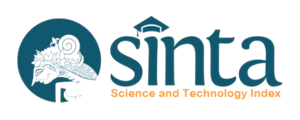A Set of English Instructional Materials Using Task-Based Learning for News Production Management Study Program in STMM MMMTC Yogyakarta
(1) Sanata Dharma University, Yogyakarta
(*) Corresponding Author
Abstract
Full Text:
PDFReferences
Wadasworth Thomson Learning.
Bari, H. (1995). Teknik dan komunik a s i p e ny i a r tel e v i s i - radio-MC: sebuah pengetahuan praktis. Jakarta: PT. GramediaPustakaUtama.
Berner, T. R. (1992). The process of writing news. Boston: Allyn & Bacon.
Best, W. (1970). Research in education. London: Prentice Hall.
Bogdan, R. C., &Biklen, S. K. (2003). Qualitative research for education: An introduction to theory and methods (4th ed). Boston: Allyn & Bacon.
Boone, H. N., & Boone, D. A. (2012). Analyzing Likert Data. Journal of Extension.50(2), 1-5.
Borg, W. R., & Gall, M. D. (1983). Educational research: An introduction (4th ed). New York: Longman Inc.
Borg, W. R., Gall, M. D., & Gall, J. P. (2007). Educational research: An introduction (8th ed). New York: Longman Inc.
Brown, J. D., & Rodgers, T. S. (2002). Doing second language research. Oxford: Oxford University Press.
Cresswell, J. W. (2003). Research design: Qualitative, quantitative, and mixed methods approaches (2nd ed). London: Sage Publications Ltd.
Dudley-Evans, T. (1998). Developments in English for specific purposes. New York: Cambridge University Press.
Dudley-Evans, T., & St. John, M. (1998). Developments in ESP: A multidisciplinary approach.
Cambridge: Cambridge University Press.
Fraenkel, J. R., &Wallen, N. E. (1993). How to design and evaluate research in education. New York: McGraw Hill.
Gagne, R. M., & Briggs, L. J. (1979). Principles of instructional design. New York: Holt, Rinehart, and Winston.
Graves, K. (2000). Designing language courses: A guide for teachers. Boston: Thomson Heinle.
Hudelson, S. (1993). English as a second language curriculum resource handbook. New York: Krause International.
Hutchinson, T., & Waters, A. (1987). Specific purposes. Cambridge: Cambridge University Press.
Ishwara, L. (2005). Catatan-catatan jurnalisme dasar. Jakarta: Penerbit Buku Kompas.
Jeremy, D., &Krzanowski, M. (2011). Teaching English for specific purposes: An introduction. Cambridge: Cambridge University Press.
Johnson, K., & Porter, D. (1983). Perspectives in communicative language teaching. Boston: Academic Press, Inc.
Joyce, Bruce, & Weil, M. (1986). Models of teaching. New York: Prentice Hall, Inc.
Keir, D. (1957). Newspaper. Camden Town: Edward Arnold Ltd.
Kemp, J. E. (1977). Instructional design (plan for unit and course development) (2nd ed). Belmont, CA: Fearon-Pitman.
Larsen-Freeman, D. (2000). Techniques and principles in language teaching. Oxford: Oxford University Press.
Likert, R. (1932). A technique for the measurement of attitudes. Archives of Psychology, 22(140), 1-55.
Littlework, W. (1977). Communicative language teaching: An introduction. New York: Cambridge University.
Lodico, M. G., Spaulding, D. T., &Voegtle, K. H. (2010). Methods in educational research: From theory to practice (2nd ed). Hoboken: John Wiley & Sons, Inc.
Marshall, C., &Rossman, G. B. (2006). Designing qualitative research (4th ed). Thousand Oaks, CA: Sage Publications, Inc.
McCracken, G. (1998). The long interview. Newbury Park, CA: Sage.
Merriam, S. B. (2009). Qualitative research: A guide to design and impelementation. San Fransisco, CA: John Wiley & Sons, Inc.
Metlzer, K. (1986). Newsgathering. Englewood Cliffs, NJ: Prentice Hall, Inc.
Meltzer, K. (2010). TV news anchors and journalistic tradition: How journalists
adapt to technology. New York: Peter Lang Publishing.
Miles, M. B., &Huberman, A. M. (1994). Qualitative data analysis: An expanded sourcebook (2nd ed). Thousand Oaks, CA: Sage.
Morgan, D. L. (1998). The focus group guidebook. Thousand Oaks, CA: Sage Publications, Inc.
Nunan, D. (2003). Practical English language teaching. New York: McGraw Hill Companies.
Nunan, D. (2004). Task-based language teaching. Cambridge: Cambridge University Press.
Olii, H., M. M., &Hozilah, L. (2013). Reportase radio &televisi: Bahan ajar di perguruan tinggi(Edisi ke-2). Jakarta: PT. Indeks.
Patton, M. Q. (2002). Qualitative research and evaluation methods (3rd ed). London: Sage Publications Ltd.
Reah, D. (2002). The language of newspaper (2nd ed). New York: Routledge.
Reddick, D. C. (1941). Journalism and the school paper. New York: D. C. Health and Company.
Richards, J. C. (2001). Curriculum development in language teaching. New York, NY:
Cambridge University Press.
Richards, J. C. (2002). Planning aims and objectives in language programs.Singapore: SEAMEO Regional Language Centre.
Richards, J. C. (2005). Communicative language teaching today. Singapore: SEAMEO Regional Language Centre.
Richards, J. C., & Rodgers, T. S. (2001). Approaches and methods in language teaching (2nd ed). Cambridge: Cambridge University Press.
Rivers, W. M. (1983). Communicating naturally in a second language: Theory and practice in language teaching. Cambridge: Cambridge University Press.
Romli, A. S. M. (2005). Jurnalistik praktis untuk pemula. Bandung: PT RemajaRosdakarya.
Seliger, H. W., &Shohamy, E. (1989). Second language research methods. Oxford: Oxford University Press.
Silverman, D. (1993). Interpreting qualitative data: Methods for analyzing task, text, and interaction. Thousand Oaks, CA: SAGE Publications Inc.
Skehan, P. (1996). A framework for the implementation of task-based instruction. Oxford: Oxford University Press.
Stake, R. E. (1994). Handbook of Qualitative Research. Thousand Oaks: Sage Publications.
Strauss, A., & Corbin, J. (1998). Basics of qualitative research: Techniques and procedures for developing grounded theory. City Road, London: SAGE Publications Ltd.
Tomlinson, B., & Masuhara, H. (2004). Developing language course material. Singapore: SEAMEO Regional Language Centre.
Websters Encyclopedic Unabridged Dictionary of the English Language. (1996). San Diego, CA: Thunder Bay Press.
Widdowson, H. C. (1987). Aspects of syllabus design. Singapore: RELC.
Willis, J. (1996). A framework for task-based learning. London: Pearson Education.
Wong, M. R., & Raulerson, J. D. (1974). A guide to systematic instructional design. Englewood Cliffs, NJ: Educational Technology Publications, Inc.
Yunus, S. (2010). Jurnalistik terapan. Bogor: PenerbitGhalia Indonesia.
DOI: https://doi.org/10.24071/llt.v18i1.246
Refbacks
- There are currently no refbacks.
Copyright (c) 2016 Geovanna Gistha Wicita
LLT Journal: A Journal on Language and Language Teaching Sinta 1 Certificate
.jpg)

This work is licensed under CC BY-SA.
Creative Commons Attribution-ShareAlike 4.0 International License


.png)

















